I was given a rest day before coming back to Singapore. The ‘rest day’ was more like a half day of transition from my night shift to the day. After finishing my work at 8.30am, I got back to the hotel as fast as possible, finishing my breakfast, washing up and I’m ready to take a cab to the train station at 9.15am. The trip this time will be reminiscent of a similar one in Taiwan a year back which I got down to Taipei straight away after night shift work. It will be 24-hr non-stop work and travel.
After reviewing a few travel books and the sharing given by my colleagues from another site who have been there, the plan for today will be as follows:
First I will hop on a cab from the Suzhou station to Huqiu Shan (1). After spending a recommended of 1.5 hours there, I will proceed next to Hanshan Si (2), also by cab. Thereafter I will go on to Xi Yuan (3) which is a short distance away. This time I will either travel by foot or by cab again depending on the time available. And finally go on to Suzhou central for another dash at their gardens or visit their shopping street (4).
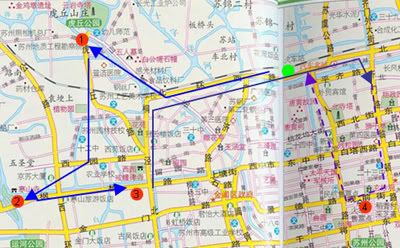
1. Getting to the Huqiu Shan
I left the hotel at 9.15am and got to the train station at 9.30am, with the taxi charges coming up to 26RMB. It is followed by another 30 minutes queue at the station. I'm actually quite surprised by the large crowd at the counters, considering it is a Wednesday weekday. The ticket to Suzhou cost 11RMB (with seat reservation) and the train departs at 10.30am. I arrived at Suzhou station at 10.55am and proceeded to get the return ticket. The return ticket cost 15RMB and I opted for the 6.30pm train instead of the 9pm one (considering that it is a 24-hr bash instead of a day-trip).
Thereafter I went to the station's taxi stand. Queuing for taxi is quite a breeze with the trip down to Huqiu coming up to 15RMB after a 10 minutes ride.
I walked straight up to the counter with tickets coming in at 60RMB each. Here is the first sight of Huqiu Shan from the entrance. The famous leaning tower of Huqiu Shan can be seen prominently behind.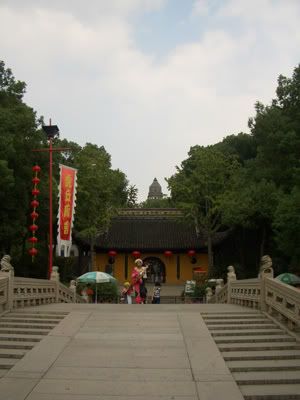
2. Huqiu Shan
According to travel books, Huqiu Shan is famous amongst the locals. This is the top sight in Suzhou as recommended by many chinese forums. While travelling between Shanghai airport and Wuxi, the pagoda will always be a sight that can be seen from the highway. Finally, I have arrived at Huqiu Shan after much anticipation.
There is a frequent chinese saying that "In a mountain, there is a temple". While Huqiu Shan is the opposite, "There is a mountain in the temple". The temple entrances actually encircle the mountain with the top of the mountain marked by the famous Pagoda.
So here we are trudging our way up the mountain stairs to the top.
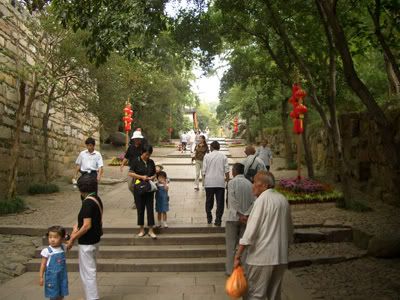
There are quite a number of guides around that give detailed explanations to every nook and canny. A great number of stories surround the rock formations that surround the steps up the mountain top. I listened to one of the explanation on why the rock is cracked into two below. It is actually split by a sword, or so the story goes.

At the midway mark of Huqiu Shan, we came upon many of the natural springs in the mountain. The bridges that arch through the mountain springs and waters make the whole place feel like a multi-layered city. The last time I got this feeling was in Edinburge where it is truly a multi-layered city with many bridges spanning around.
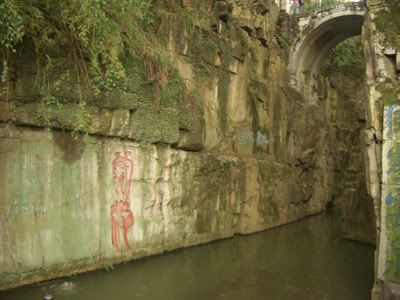
The picture below shows the 'Third Natural Spring' as recorded in Cha Jing (Art of Tea).
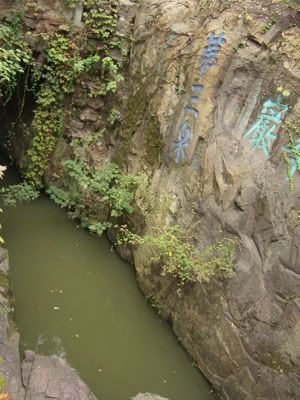
At the mid-mountain space, there are two paths leading to the mountain top. To the right there is a main temple hall. I find the temple hall to be quite commericialised, with stalls being setup to the left and right of the main Buddha representation. The arahats images are blocked by the stalls in front.
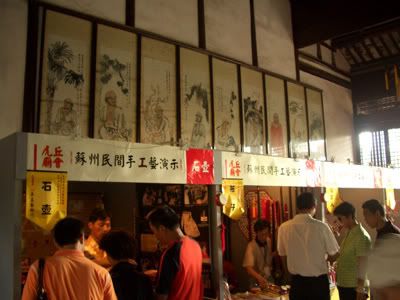
Taking the other mountain path up leads to this classic bridge with two holes in the middle. These are actually wells which allow the monks to draw water from the river below in ancient times. As the story goes, a large number of monks will assemble to draw water from the well with 7 passing the pails to the top and 8 passing it back down (there is a Chinese idiom which simplify this phrase).

And here we are finally at the leaning tower of Huqiu Shan. The inclination is actually more acute than seen from afar. Using the 3 visitors at the horizontal mark below, we can measure the inclination of the tower. The tower has no threat of collapsing but it will just happen if hit by a typhoon or earthquake. This tower has been standing for over a thousand years. Looks pretty ancient...
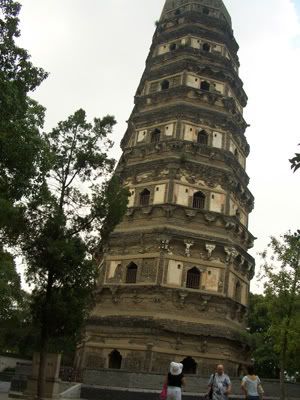
This is the top of Huqiu Shan. And it pretty marks the end of the 'adventure' in Huqiu Shan. The time now is 12.15pm. I decided to make a final walk round the mountain before leaving. I arrived at a Chinese Bonsai garden which is to the East side of mountain.
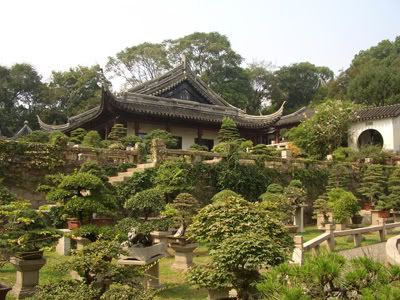
There are also rock bonsai where rocks are shaped in unique shapes and sizes.

On the way out of the temple grounds, I saw a dragon troope walking in up the mountain. I heard there are regular performances there but do not really know what time it is. It is 12.40pm. So I just tag along behind them together with the other visitors. The show started at the open space at mid-mountain at 12.55pm and ended at 1.15pm.
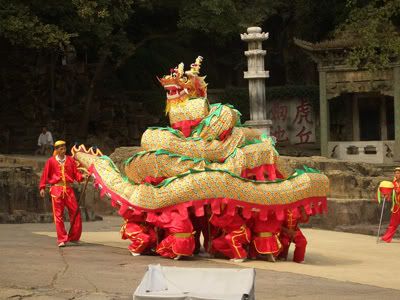
It is followed by the main highlights of the day, the cultural performances of Huqiu Shan. Several performing groups are invited daily. And the first performance of the day is Shaolin Gong Fu. The performers are actually quite young.

The next performance is The Thousand Arms Guan Yin. I have seen this on TV and on the net several times. This time it is live. With the representation of Guan Yin behind, it is really a fitting performance.
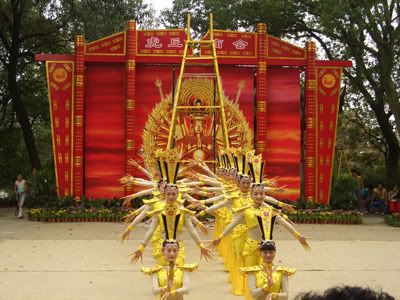
Next is acrobatic performance. The performers are aged 15 (Guy) and 13 (Girl) where they use the red cloth to fly around the compound.
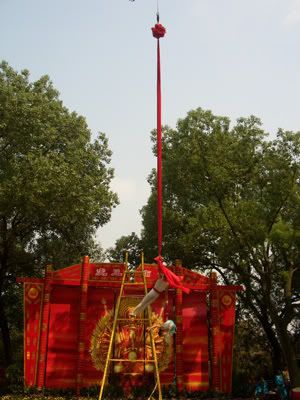
Here we have demonstrations of masks. One of the intriguing part of the show is that the performers are able to remove and put on their masks at split seconds timing. Leaving all the audience wondering how do they do it.
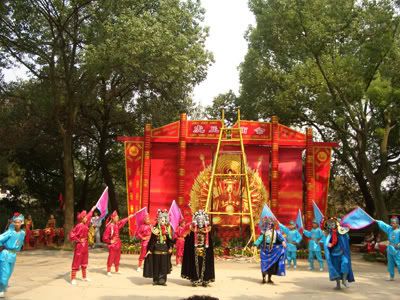
Next we have acrobatic display again. It started with 1 boy doing the jump from the pole and back up again. The show climax is slowly increased to 4 boys doing it concurrently. It requires precise timing for them to do it accurately. We are all very impressed by their synchronized performance. 
Last but not least we have performances by the drummers. It showcase all the drum instruments used by the various tribes of China (not just the Hans). The troupe have the privilege of performing twice on national television (CCTV) and be watched by billions. I really find the drumming performance to be the best and is really fitting to be the finale show of the day. I have recorded a minute long clip below for all to take a peek at.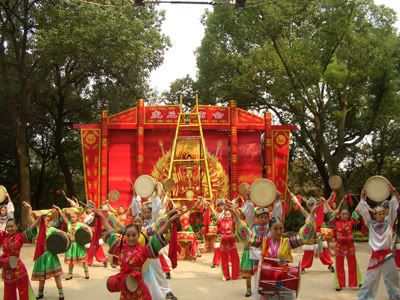
The performances officially ended at 1.40pm. Gosh, I have spent too much time here as stipulated. But nevertheless it is time well spent as I am naturally drawn to cultural performances. When I left the performing area, there is a orchestra ongoing at one of the pavilion.
Near the exit, I was brought back to see a troupe of performers with drums and bells walking past. There are '3 kids' standing on top of 3 adults. Some of the fellow visitors remarked that the 3 kids are actually puppets. From the makeup they have, they really looked like puppets, but on closer inspections, they are real children! To confirm, I followed them till a stop where a crowd has gathered to interact with the performers. The children are sitting next to the adults and smiling at the visitors.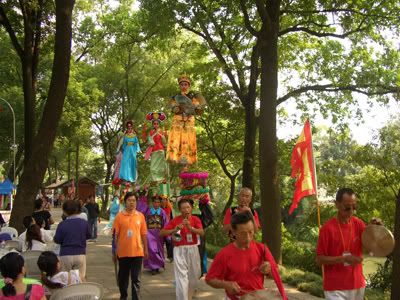
There is also the classic Wayang stage show at one of the parks. The whole place is fulled of cultural performances and activities at this time. And the best part is, it is a weekday and I don't have to compete with visitors for places to catch these performances.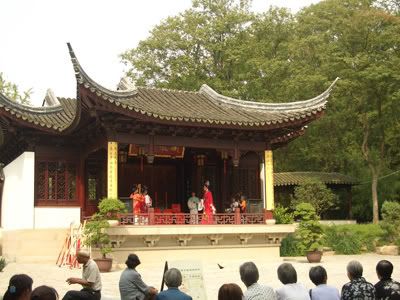
3 Han Shan Si
The next stop is Han Shan Si. I hop on the cab and it is a 5 minutes ride at 12RMB to Han Shan Si. Han Shan Si is quite famous to the Japanese as there is a similar temple in Japan.
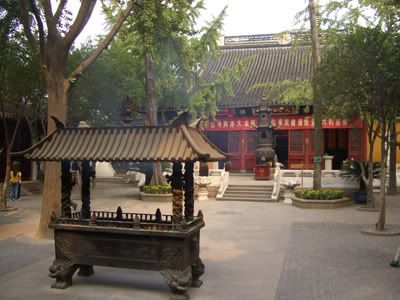
There is the hall of Arahats in the temple. It is actually a Suzhou custom to count the number of Arahats in order to forecast their fortune for the year.

Here we have an image of Han Shan.
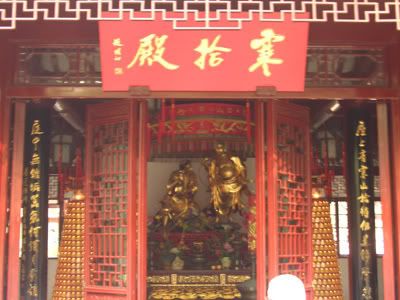
I find the name of the exit to be quite fascinating and took a shot of it. It read, "Door of Liberation". A few years back in a retreat where a fellow practitioner remarked at the end that he is 'liberated'. Another fellow practitioner remarked, he is 'liberated' from the retreat but not yet 'liberated' from samsara. It sounds really humorous in Chinese.

And here we have the pagoda. There are also many guides bringing the visitors around and I have the chance of listening to some of the stories that surround all these sights.
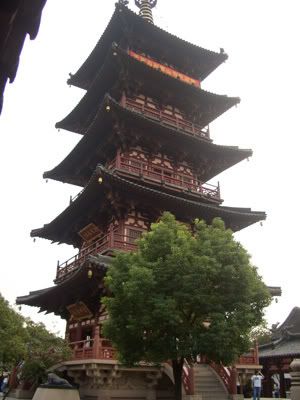
4 Xi Yuan (West Garden)
After spending about an hour wondering through the temple grounds, i went on to my next stop - Xi Yuan. Xi Yuan isn't really the top 4 gardens of Suzhou but I am drawn to it as it is the main Buddhist garden in Suzhou. It took me another 5 mins at 10RMB to the temple. Had quite a jovial conversation with the cab driver and asked me why am I visiting Xi Yuan, I told him my visits today are oriented around Buddhist cultural sites. Before I alighted, he told me to keep a look out for trees planted by Liang Chao Wei and Liu Jia Lin.
Here is the main entrance of Xi Yuan. I saw the trees planted by them in the Buddhist year of 2548.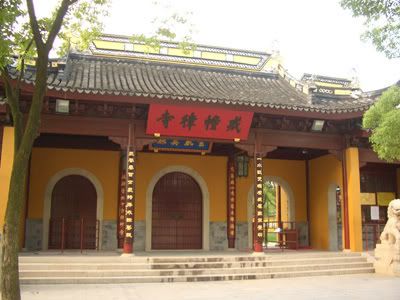
The garden grounds look vast and peaceful.
Upon entering the main temple grounds, I saw a group of ladies getting ready for their afternoon performances. The monks at the halls on both sides also just came up to the door and watched proceedings.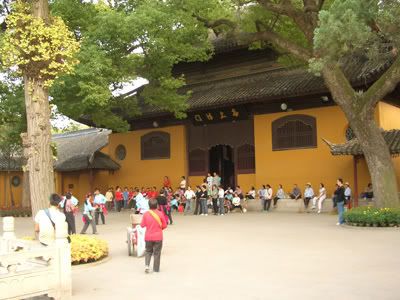
One of the main highlights of the temple is the Hall of Arahats. There are actually 700 plus life-size arahats in the hall.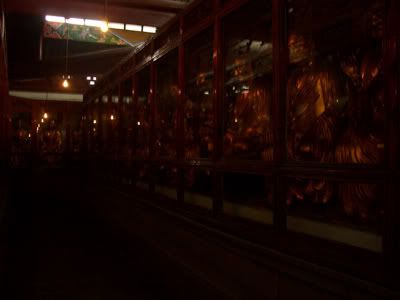
While wondering through the garden, I noticed this fascinating sight. A monk is 'communicating' with a bird perched on his arm. Is it the power of metta that draws animal to him?
I sat there and continued observing the sight. He continued his stroll round the garden and the bird jumped down to the stone parapet. It noticed that I am sitting by the bench and flew on to my side. It began peeking to my bag which I left on the floor. The monk made his round back to where I'm sitting and I told him that this bird is quite 'friendly'. He remarked that it has actually been domesticated and hence is friendly towards humans. Well. Tat's cute. He continued on the stroll and signalled to the bird to come along.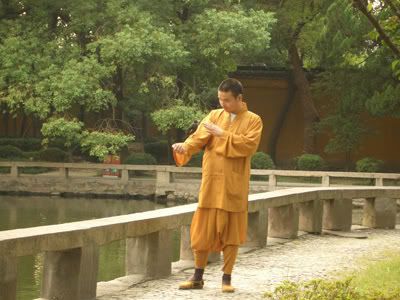
After spending around an hour in Xi Yuan, I find that it is time to leave. The garden is really a peaceful and tranquil place to just chill out from a day's work. The aura of blissfulness can be felt through the temple grounds. Thankfully it has not been overwhelmed by the tourist hordes that are seen throughout the rest of Suzhou, thus the charm of Xi Yuan can still be felt.
5 Central Suzhou
Next stop is Central Suzhou. I decided to experience how the locals travel around Suzhou and hop onto one of the many buses that come along. I took Bus number 40 from Xi Yuan to around central Suzhou which costs 2RMB at a 15 minutes journey. It is followed by another 2 hours of walk around.
The objective is to reach Guang Qian Jie which is the modern shopping street of Suzhou. All shopping malls and streets throughout the world look and feel the same. Guang Qian Jie is the answer to Nanjing East road of Shanghai.
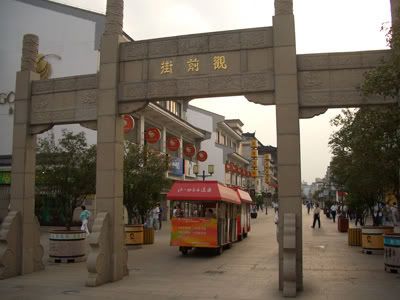
Right in the middle of the modern shopping street is a Taoist temple which has been here for hundreds of years. It offers solace from the hectic schedule of non-stop shopping.
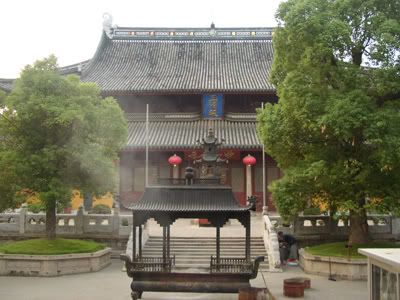
Finally, it is time to return back to the train station. After getting a few local products, I managed to get to the station at 6.15pm. And off I go back to Wuxi.